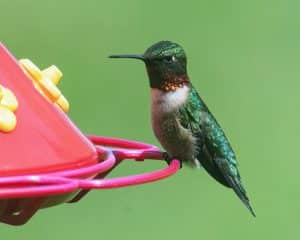Hummingbirds buzzing into area
This is the time of the year residents typically see the arrival of hummingbirds in Monroe County.
The ones seen now are Ruby-throated hummingbirds. Other varieties may be seen later in the summer.

home of Republic-Times photojournalist Alan Dooley
southeast of Waterloo on April 25. He displays the
characteristic colors, including an iridescent “ruby”
throat, which he uses with aerial demonstrations to
attract a female mate.
John Rendleman of Waterloo was among the first to report the arrival of these tiny creatures when he posted a photo April 11 on Facebook. Others started to see arrivals last week.
Hummingbirds feed on nectar from flowers and small flying insects. You can attract them to your home either by planting flowers they especially like or by placing feeders on your property. They are seen most often in morning and early evening hours.
Males arrive first, with females – without the ruby throats – following suit a week or two later.
The females build nests to lay and incubate two eggs for 11-14 days. They will also solely feed and care for the hatchlings. The newborn birds will leave the nests in about 18-21 days, and she will care for them for a few more days.
Ruby-throated hummers often breed twice in one season around here.
Shelt and Nancy Roy of Waterloo are very knowledgeable about these birds. The Roys hosted visitors to their property for years when they had large nets erected to catch these birds to be banded so their lives could be documented. The birds normally return to the same areas. From 2005 to 2016, they saw more than 1,000 of them banded and recorded.
It is impossible to know how many hummingbirds they hosted in any one year, but Nancy Roy said they used more than 500 pounds of sugar feeding them in 2011. She said one bird – which her husband Shelt paid to sponsor when it was banded — was recaptured at their place the following three consecutive years.
“We had hundreds of coral bell flowers that seemed to attract the birds with their nectar and color,” she said.
Columbines, petunias and larkspur are other flowers that attract hummingbirds.
In addition, they boiled a large pot of water daily and added sugar in a ratio of one part cane sugar and four parts water to make their feeder nectar.
“What we didn’t use we kept in jugs in the refrigerator,” she said.
As they get used to people, hummingbirds are known to fly very close to them, sometimes even feeding out of a hand-held jar lid if you are patient and steady handed.
Experts advise placing feeders in shaded or sheltered areas, such as under an awning or tree. And feeders must be kept clean. The birds introduce bacteria into them as they feed, which can cause clouding of the nectar and possible bacteria growth in the feeders.
They must therefore be cleaned thoroughly, using a mild dish soap and warm water. There are brushes and sponges sold that help with this process.
Some people use more sugar in their homemade nectar and Nancy Roy said they did so early in the year when newly arriving migrating birds were arriving from as far away as Mexico and Central America, and in the fall when birds were getting ready to make their return flights.
Although they may seem to disappear abruptly in the fall, leaving a few feeders out – perhaps half-filled – is good to sustain those migrating through from further north.
If you observe visiting hummingbirds closely, you may note that early-arriving males may sit on the feeder or on a nearby tree branch or fence. They are very territorial birds and will often aggressively drive other hummingbirds away. This alone is a good reason to have more than one feeder, spaced apart.
How long are their migratory flights? Many fly across the Gulf of Mexico – 500 miles to and from Central America – in an 18-22-hour non-stop journey. They do so twice a year for a normal life span of 3-5 years, which according to some experts can be as many as nine years.
The characteristic humming sound comes from their rapid wing beats – up to 53 times a second.
And why do hummingbirds hum? Well, as the old joke goes, they simply don’t know the words.






